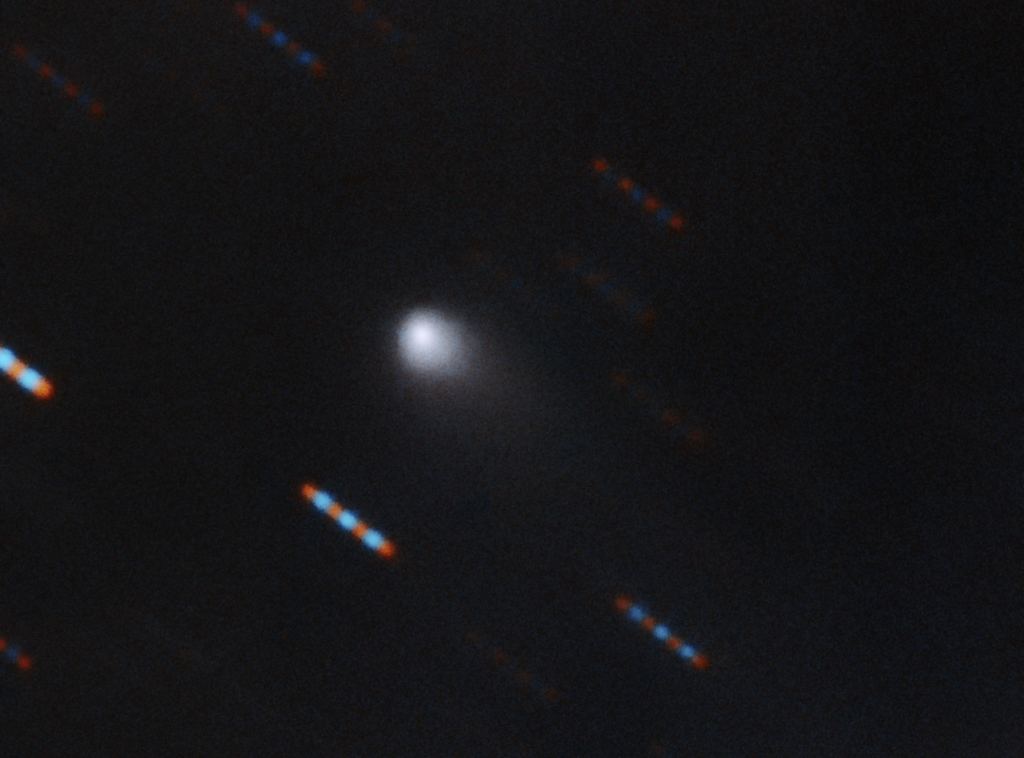On August (th,) , astronomers with NASA, the ESA, and theInternational Scientific Optical Network(ISON) announced the detection of the interstellar comet C / 2019 Q4 (2i / Borisov) . News of the object was met with a great deal of excitement since it was only the second interstellar object to be detected by astronomers – the first being the mysterious object known as’ Oumuamua (which astronomers are still unsure about)!
After a lot of waiting and several follow-up observations, 2I / Borisov is about to make its closest approach to Earth. To mark the occasion, a team of astronomers and physicists fromYale Universitycaptured a close-up image of the comet that is the clearest yet! This image shows the comet forming a tail as it gets closer to the Sun and even allowed astronomers to measure how long it has grown.
The image was captured last Sunday (Nov. 24 th) using theKeck I Telescope’s Low-Resolution Imaging Spectrometer, located at theWM Keck Observatoryin Manua Kea, Hawaii. The team was led by Peier van Dokkum, the Sol Goldman Family Professor of Astronomy at Yale, and Professor Gregory Laughlin, with the assistance of Shany Danieli and Cheng-Han Hsieh (a PhD student and undergrad, respectively).

Based on the image they captured, van Dokkum and his colleagues estimate that the comet’s tail extends for a distance of almost 160, (km) 100, (mi). For comparison, Earth measures 12, (km) 7917 .5 mi) in diameter, which makes 2I / Borisov’s tail 14 times the size of Earth. To put that in perspective, the team superimposed an image of Earth next to the comet to illustrate the difference in size.
“It’s humbling to realize how small Earth is next to this visitor from another solar system,” van Dokkum said.
It is important to note, however, that the solid nucleus of the comet measures only 1.6 km (one mile) in diameter. As with all comets, frozen material in the core (volatile materials like frozen water, carbon dioxide, etc.) began to sublimate as it got closer to the Sun. This sublimated material, mixed with dust from the surface, then formed a gaseous envelope that became stretched out into a tail.
Since it was first detected entering the Solar System this past summer, astronomers have been able to capture images of 2I / Borisov on two occasions. Thefirst image(shown above), captured 2I / Borisov’s pronounced tail and confirmed that it is actually a comet, was taken by astronomers using the Gemini North Telescope’sGemini Multi-Object Spectrographon the night of September 9- 10 th.

Thenext image(shown above) was captured on Oct. 12 th by a team from the University of California, Los Angeles (UCLA) using the Hubble Space Telescope. At the time, 2I / Borisov was within (million km) 260 million mi) of Earth. The images showed the progression of 2I / Borisov’s sublimation and the formation of its tail, which was already becoming rather long at this point.
2I / Borisov will be reaching the closest point in its orbit to the Sun (perihelion) on December 8th, where it will be near the inner edge of the asteroid belt. When it makes its closest approach to Earth (in late December) it will pass us at a distance of over (million km) (million mi) – a little over to 2 AUs (or twice the distance between Earth and the Sun).
It will be passing beyond the orbit of Mars at this point, which means that it will pose no threat to Earth. This in spite of the fact that astronomers recently detectedtraces of cyanidein the comet. So as Douglas Adams would say, “Don’t Panic!”
This comet and its predecessor, ‘Oumuamua, have raised awareness about the presence of interstellar objects in our system and how regularly they pass through. In the coming years, space agencies around the world hope to be able to mountmissions to intercept and studyone of them. These include the ESA’s proposedComet Interceptormission, which is scheduled for launch sometime in 2028.
Further Reading:Yale News







GIPHY App Key not set. Please check settings